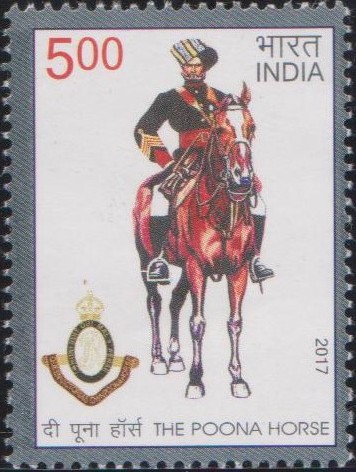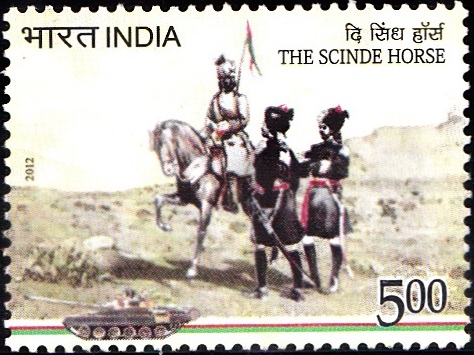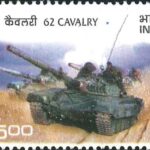
The Poona Horse
A commemorative postage stamp on the Bicentenary of the Poona Horse, an armored regiment in Indian Army Armoured Corps :
 Issued by India
Issued by India
Issued on Feb 11, 2017
Issued for : Department of Posts is proud to release a Commemorative Postage Stamp on The Poona Horse on the occasion of Bicentenary of its raising.
Credits :
Stamp/FDC/Brochure/Cancellation Cachet : Smt. Alka Sharma
Type : Stamp, Mint Condition
Colour : Multi Colour
Denomination : 500 Paise
Stamps Printed : 403640
Printing Process : Wet Offset
Printer : Security Printing Press, Hyderabad
About :
- The Poona Horse Regiment was raised on 15 July 1817 at Sirur near Pune and will be completing its 200 years of raising in July 2017. The Poona Horse which has the distinction of being one of the most decorated regiments in the Indian Army will complete 200 glorious years in 2017.
- The Poona Horse as it exists today is an amalgamation of two of the finest cavalry regiments of the erstwhile Bombay Presidency. The forebears of the Poona Horse were raised as part of an auxiliary force, for service in the territory of the Peshwa. The regiment was not yet fully raised when it was blooded in the battle of CORYGAUM. A small detachment of 300 horsemen was pitted against 28600 horsemen and foot soldiers and successfully resisted the adversary. The Regiment has never looked back since. In 1820, also at Sirur, was raised the 3rd Bombay Light Cavalry.
- In 1856, the Shah of Persia invaded Afghanistan. The Poona Horse and the 3rd Bombay Light Cavalry were both part of the expeditionary force. This was the first occasion when the sheer weight, momentum and daring of a cavalry charge broke up the Infantry square. The Poona Horse annihilated the Persian 1st Khusgai Regiment (who were the Shah’s bodyguards), spiked their guns and captured their Standard which dates back to AD 1066.
- Lt AT Moore & JG Malcolmson were awarded VC during the battle of KOOSHAB. In 1858 Lt H.E. Wood (later Field Marshal) was awarded the 3rd Victoria Cross and during World War-I, Lt FA De Passe was awarded the 4th Victoria Cross posthumously.
- On Independence, the Kaimkhani Squadron opted for Pakistan and their place was taken by the Sikh squadron of the 13th Lancers, who soon became a part and parcel of the Regiment and imbibed the ‘PH Spirit’. The regiment played a stellar role in the Hyderabad Police action immediately after partition in 1948.
- On 8th September 1965, the Regiment spearheaded the Indian advance into Pakistan. The Regiment cleared the stronghold of Phillora after a gruelling close range battle with enemy Patton Tanks. At the end of the day, 23 enemy tanks lay scattered, mauled and burning on the battle fields – a tribute to the grit, daring and dash of the Regiment. This battle was the fiercest tank battle fought since the Second World War and broke the back of the Pakistani 6 Armoured Division. The Commandant Lt Col AB Tarapore was martyred in action on 16 September 1965. It was a matter of great pride and honour for the regiment that he was posthumously awarded the Param Vir Chakra, the first in Indian Armoured Corps and the only one at that time. By the end of the war the Pakistanis started to refer to the regiment as Fakhr-E-Hind (The Pride of India). The regiment emerged as the only unit to be awarded two battle honours – PHILLORA and BUTUR-DOGRANDI, one Param Vir Chakra, two Vir Chakras, five Sena Medals, twelve Mentioned-in-Despatches and six Commendation Cards.
- In the historic Battle of Basantar, 2nd Lt Arun Khetarpal showed his grit and determination to destroy enemy armour against all odds. He destroyed tank after tank till his own tank was hit. A grateful nation bestowed the Param Vir Chakra posthumously on him. At the end of that day, 56 enemy tanks lay in ruins. The Poona Horse was awarded the battle honour of BASANTAR. The gallantry awards won were one Param Vir Chakra, two Maha Vir Chakras, three Vir Chakras, three Sena Medals and ten Mentioned-in-Dispatches.
- Text : Based on the material received from proponent.
Subscribe
Login
0 Comments
Oldest







